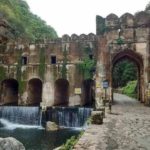Ranthambore Monuments, situated in Rajasthan, India, is renowned not only for its wildlife but also for its historical monuments, centered around the majestic Ranthambore Fort. This 10th-century fort, a UNESCO World Heritage Site, offers stunning views and houses the ancient Trinetra Ganesh Temple, attracting pilgrims and tourists alike. Below the fort, near Padam Talao, lies the historically significant Jogi Mahal, once a royal hunting lodge. The lake itself is a key spot for wildlife watching, particularly tigers.
Nearby, the atmospheric Raj Bagh Ruins echo the grandeur of past royal hunting parties with their stone structures and arches. Another intriguing site is Kachida Valley, known for its rugged terrain and wildlife, including panthers and bears. Lakarda and Anantpura, located in the park’s northern regions, are known for sloth bear sightings amidst their ancient ruins, Ranthambore Tour Packages.
Completing the historical landscape, Malik Talao, the smallest lake in the park, is a prime birdwatching spot with scenic views enhanced by surrounding historical remnants. Together, these sites make Ranthambore Monuments a unique blend of natural beauty and historical richness.
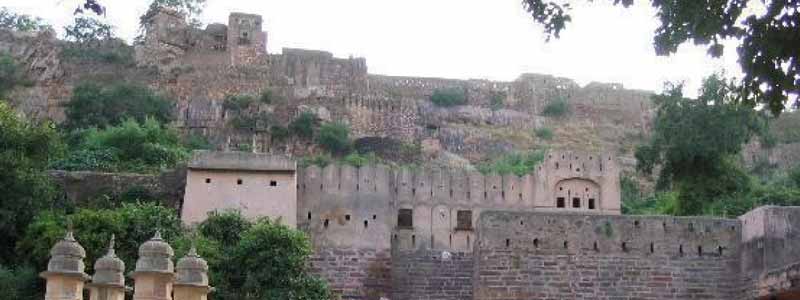
Ranthambore Fort:
Ranthambore Fort, perched atop a 700-foot high hill in Rajasthan, India, is a monumental site with a rich tapestry of history and legend, commanding panoramic views of the surrounding Ranthambore National Park. Believed to have been built in the mid-10th century during the reign of the Chauhan Rajput kings, the fort’s strategic importance was unparalleled, serving as a vital stronghold in the region.
The fort’s architecture showcases the typical Rajput style, featuring massive gates, walls, and bastions constructed from red Karauli stone. Despite numerous battles and sieges, notably by the Sultan of Delhi, Alauddin Khilji in the 13th century, Ranthambore Fort stood resilient, symbolizing the indomitable spirit of its defenders Ranthambore Monuments.
Inside the fort, there are several noteworthy constructions, including the Trinetra Ganesh Temple, one of the oldest in Rajasthan, where devotees still gather to offer prayers. The temple’s unique feature is the idol of Lord Ganesh with three eyes, drawing worshippers from across India.
The fort is not only a historical marvel but also a haven for wildlife enthusiasts and photographers, thanks to its commanding position above the national park. Declared a UNESCO World Heritage Site under the “Hill Forts of Rajasthan,” Ranthambore Fort remains a testament to the glorious past of Rajputana and a crucial piece of India’s cultural heritage.

Trinetra Ganesh Temple:
The Trinetra Ganesh Temple, nestled within the historic confines of Ranthambore Fort in Rajasthan, India, is a spiritual and cultural landmark with deep historical roots. This ancient temple, dedicated to Lord Ganesh, the Hindu deity known as the remover of obstacles, is distinguished by its idol depicting Ganesh with three eyes, from which it derives its name “Trinetra” meaning “three-eyed.” Ranthambore Monuments
According to local legend, the temple was established in the 13th century when a war-weary king prayed for divine intervention to resolve a crisis besieging his kingdom. Lord Ganesh appeared in his dream and promised that his problems would be resolved by the morning. True to the vision, the issues the king faced were miraculously solved, prompting the construction of this temple as a mark of gratitude.
Located at a formidable elevation within the fort, the temple commands a panoramic view of the entire park and becomes a focal point during the Ganesh Chaturthi festival, drawing thousands of devotees from across the nation. The temple’s architecture is a blend of the fort’s rugged military construction and spiritual grace, housing not only the idol of Ganesh but also those of his entire family, making it a unique ensemble seldom found in other Ganesh temples.
Today, the Trinetra Ganesh Temple remains a beacon of faith and history, attracting both pilgrims and tourists who come to witness its ancient beauty and seek blessings Ranthambore Monuments.
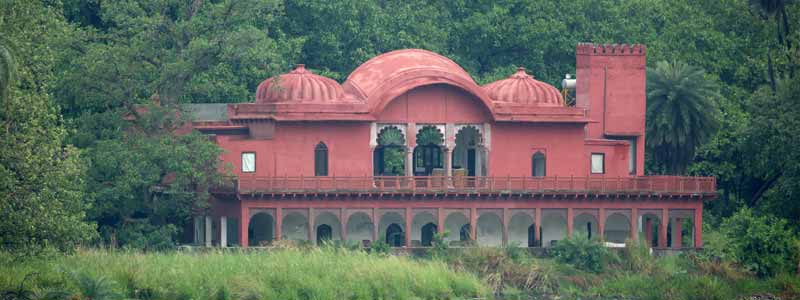
Jogi Mahal:
Jogi Mahal in Ranthambore, once a royal hunting lodge, is a historical building located at the edge of Padam Talao, the largest lake in Ranthambore National Park, Rajasthan, India. This lodge was traditionally used by the Maharajas of Jaipur during their hunting expeditions in the dense forests of Ranthambore, which were once private hunting grounds for the royal family. Over the years, Jogi Mahal has earned a reputation not only for its historical significance but also as a picturesque spot for viewing Ranthambore’s vibrant wildlife and scenic landscapes.
Though now the access to Jogi Mahal itself is restricted to the public, its location remains a popular draw for tourists. The Mahal sits strategically near Ranthambore Fort, providing an excellent vantage point over the lake and the surrounding jungle. The architecture of Jogi Mahal reflects typical Rajasthani style, with ornate stone carvings and traditional design elements that blend seamlessly with the natural beauty of the area Ranthambore Monuments.
The iconic sight of the Mahal, with the backdrop of the dense forest and the calm waters of Padam Talao dotted with lilies, creates a serene and almost mystical atmosphere. This spot is particularly famous for bird watching and spotting animals like tigers, who often visit the lake to drink. As part of the greater Ranthambore National Park, Jogi Mahal continues to be an integral part of the park’s allure, combining rich history with stunning natural beauty.
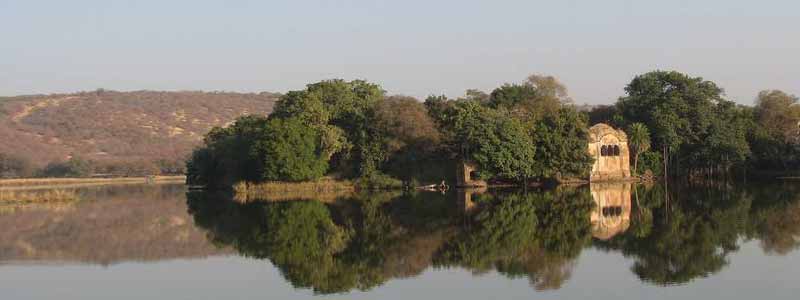
Padam Talao:
Padam Talao is the largest of the lakes located within the famed Ranthambore National Park in Rajasthan, India. Named after the lotuses that bloom here, adding to its ethereal beauty, the lake serves as a critical watering hole for the park’s wildlife and is a prime spot for tiger sightings. The serene waters of Padam Talao reflect the lush surroundings and the historical Ranthambore Fort which towers over the landscape from nearby hills.
Adjacent to Padam Talao stands the iconic Jogi Mahal, a former royal hunting lodge that exemplifies the architectural beauty of the region. Although no longer open to the public, Jogi Mahal’s picturesque setting at the lake’s edge draws the attention of visitors. This area is particularly popular during the early mornings and late afternoons when tigers and other wildlife are most active.
Birdwatchers also find Padam Talao a haven, as it attracts a variety of migratory and native birds, making it an ideal spot for bird photography. The presence of lush flora around the water provides a vibrant backdrop, enhancing the natural beauty of the scene Ranthambore Monuments.
Overall, Padam Talao is not just a wildlife sanctuary but a symbol of the delicate ecosystem of Ranthambore, embodying the intersection of natural beauty and historical significance, making it a must-visit spot in the park.
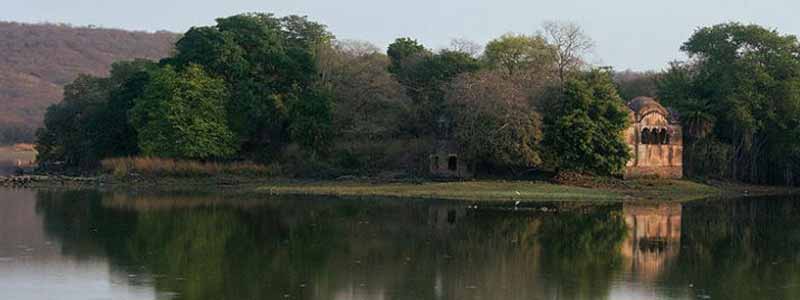
Raj Bagh Ruins:
The Raj Bagh Ruins, nestled in the heart of Ranthambore National Park in Rajasthan, India, are a captivating testament to the region’s royal past. These ruins are strategically located between the park’s two largest lakes, Padam Talao and Raj Bagh Talao, making them not only a scenic spot but also a prime location for wildlife sightings. The architectural remnants consist of ancient stone structures, including arches, palace outhouses, domes, and step wells, all draped in a cloak of wild greenery that adds to their mystique.
The Raj Bagh Ruins exude an aura of timelessness and romance, offering visitors a glimpse into the luxurious and leisurely outings of erstwhile maharajas. This site is thought to have been used as a resting area for the royal hunting parties that frequented the dense forests of Ranthambore Monuments. Its central location within the park makes it a favorite haunt for the park’s tigers, who are often spotted lounging among the ruins or drinking at the nearby lakes, much to the delight of wildlife photographers and enthusiasts.
The juxtaposition of historical architecture and thriving wildlife makes the Raj Bagh Ruins a unique spot in Ranthambore Monuments. It is not only a relic of human history but also an integral part of the natural ecosystem, providing a serene backdrop that enhances the mystique and allure of Ranthambore National Park.
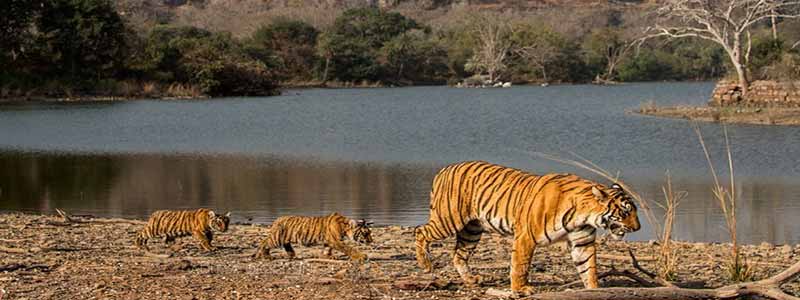
Kachida Valley:
Kachida Valley, nestled within Ranthambore National Park in Rajasthan, India, is a rugged and picturesque terrain offering a unique wilderness experience. Characterized by rocky outcrops, dense vegetation, and winding trails, this valley is a haven for wildlife enthusiasts and adventure seekers alike.
One of the key attractions of Kachida Valley is its diverse wildlife population. Visitors have the opportunity to spot elusive predators like panthers and sloth bears, as well as other fascinating species such as sambar deer, spotted deer, and various bird species. The valley’s rocky terrain provides ample hiding spots and shelter for these animals, making it an ideal habitat, Ranthambore Monuments.
Moreover, Kachida Valley is known for its scenic beauty, with breathtaking vistas unfolding at every turn. The rocky formations, interspersed with lush greenery, create a stunning backdrop for wildlife sightings and photography.
Exploring Kachida Valley offers visitors a chance to immerse themselves in the natural wonders of Ranthambore Monuments, away from the hustle and bustle of the outside world. Whether trekking through its rugged trails or embarking on a safari adventure, the valley promises an unforgettable experience for nature lovers and wilderness enthusiasts seeking to connect with the untamed beauty of the wilderness.
Lakarda and Anantpura:
Lakarda and Anantpura are two significant areas within Ranthambore National Park, Rajasthan, India, known for their wildlife and historical significance. Located in the northern and northwestern parts of the park, these areas offer a unique blend of natural beauty and cultural heritage.
Lakarda is renowned for its dense forest cover and rugged terrain, providing habitat for various wildlife species, including the elusive Indian sloth bear. Visitors to Lakarda often have the opportunity to observe these fascinating creatures in their natural habitat, making it a popular destination for wildlife enthusiasts and photographers Ranthambore Monuments.
Anantpura, adjacent to Lakarda, is equally notable for its rich wildlife and historical ruins. The area is characterized by ancient architectural remnants, offering insights into the region’s royal past. Amidst the ruins, visitors can encounter wildlife such as sloth bears, adding an extra dimension to the historical exploration.
Both Lakarda and Anantpura exemplify the diverse offerings of Ranthambore National Park, combining natural wonders with cultural heritage. Whether exploring the dense forests in search of wildlife or admiring the remnants of ancient civilizations, visitors to these areas are treated to a memorable and enriching experience that highlights the park’s ecological and historical significance.
Malik Talao:
Malik Talao, nestled within the picturesque landscape of Ranthambore National Park in Rajasthan, India, offers a tranquil retreat amidst nature’s splendor. As the smallest of the three lakes within the park, Malik Talao exudes a serene charm that attracts both wildlife enthusiasts and bird watchers alike.
Surrounded by lush greenery and bordered by ancient trees, Malik Talao provides a serene haven for a variety of bird species, making it a paradise for birdwatchers. Visitors can spot a diverse array of avian residents and migratory birds, including herons, egrets, kingfishers, and waterfowl, among others.
Beyond its natural allure, Malik Talao is also steeped in history, adding to its enchanting ambiance. Surrounding the lake, visitors can explore the remnants of historical structures, offering glimpses into the region’s storied past. These remnants serve as a reminder of the area’s rich heritage and its significance as a former royal hunting ground Ranthambore Monuments.
Whether marveling at the diverse birdlife, soaking in the tranquility of the surroundings, or delving into the historical echoes of the past, Malik Talao captivates visitors with its blend of natural beauty and cultural heritage, making it an essential stop on any exploration of Ranthambore National Park.
How to Reach Ranthambore Monuments
Reaching Ranthambore is relatively straightforward, given its popularity as a tourist destination in India. Here’s a guide on how to reach Ranthambore Monuments:
By Air: The nearest airport to Ranthambore is the Jaipur International Airport, located approximately 180 kilometers away. From Jaipur, you can hire a taxi or take a bus to reach Ranthambore. Jaipur Airport is well-connected to major cities in India and also operates some international flights.
By Train: The nearest railway station to Ranthambore is Sawai Madhopur Railway Station, which is around 10 kilometers away from the park. Sawai Madhopur is well-connected to major cities like Delhi, Mumbai, Jaipur, and Agra by regular trains. From the railway station, you can hire a taxi or take a bus to reach Ranthambore.
By Road: Ranthambore is well-connected by road to major cities in Rajasthan and neighboring states. You can either drive to Ranthambore or take a bus from nearby cities like Jaipur, Delhi, or Agra. Rajasthan State Road Transport Corporation (RSRTC) operates regular bus services to Ranthambore from Jaipur, Kota, and other cities.
Once you reach Ranthambore Monuments, local transportation options like taxis, auto-rickshaws, and jeeps are available for getting around the town and exploring the national park.








